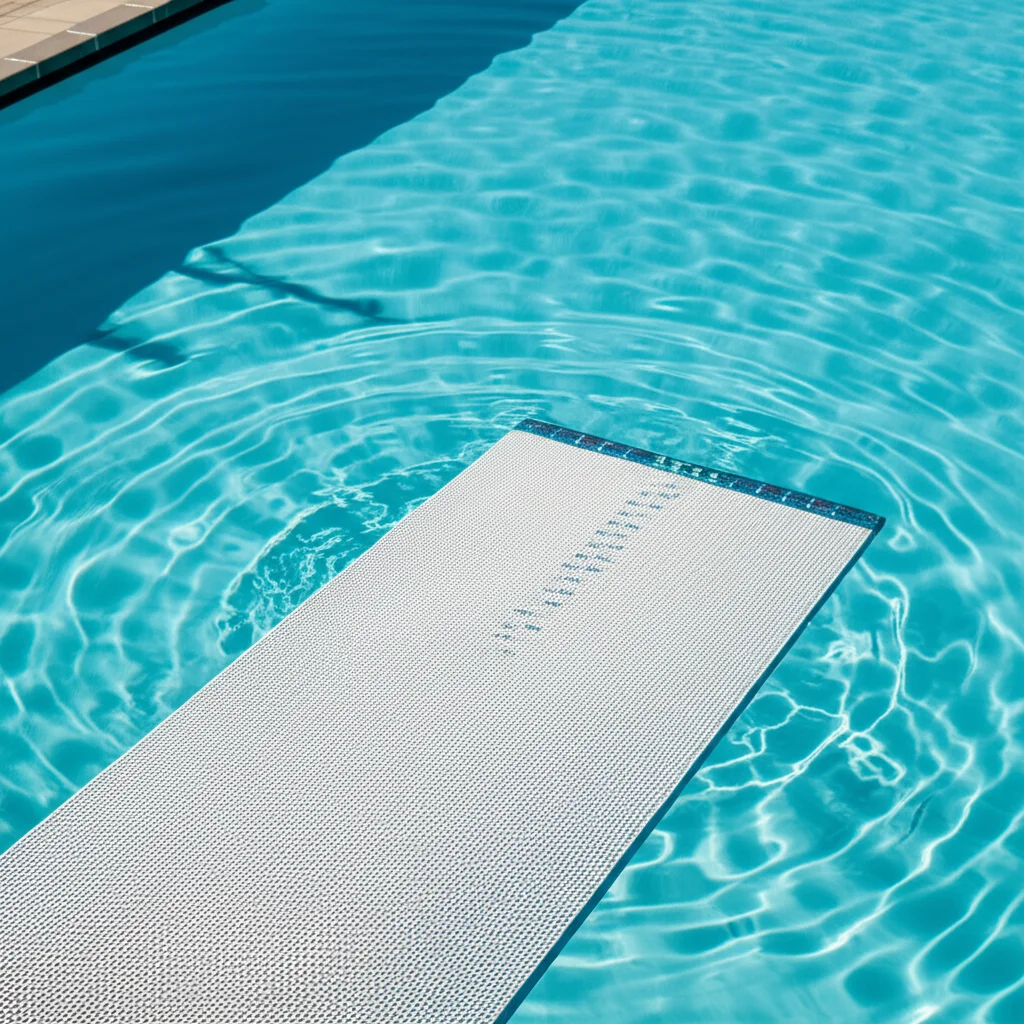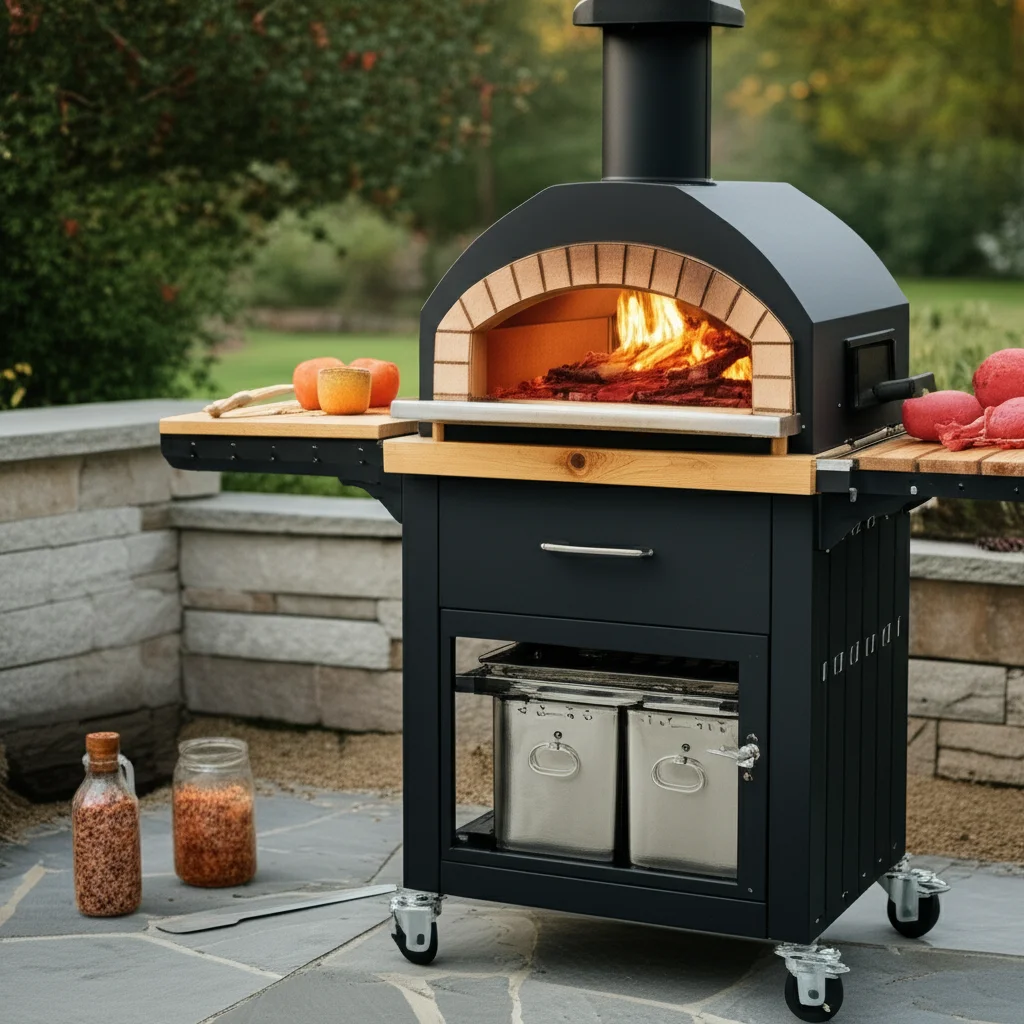· Todd Martin · Outdoor Living · 16 min read
How To Clean Diving Board

How to Clean Your Diving Board for a Sparkling Pool Season
Picture this: it’s a hot summer day, and your pool water shimmers under the sun. You glance at your diving board, ready for a refreshing plunge, but notice it looks a bit… dingy. Green patches of algae might cling to its surface, or perhaps stubborn stains mar its once vibrant color. A dirty diving board is not just an eyesore; it can also be a safety hazard. Slippery surfaces covered in grime increase the risk of falls and injuries.
Cleaning your diving board regularly is a key part of maintaining a safe and inviting pool area. It helps extend the life of the board itself, preventing degradation from harsh chemicals, UV exposure, and biological growth. This guide will walk you through everything you need to know to clean diving board surfaces effectively. We will cover essential tools, step-by-step cleaning methods, ways to tackle tough stains like mold and algae, and important safety tips. Get ready to transform your diving board from drab to dazzling, ensuring countless hours of safe, splashing fun.
Takeaway:
- Regular cleaning prevents hazards and extends diving board life.
- Use mild detergents and soft brushes for general cleaning.
- Tackle mold and algae with specific, safe solutions.
- Always prioritize safety with non-slip shoes and proper chemical handling.
- Consistent maintenance keeps your diving board sparkling and safe.
To clean a diving board, first rinse it thoroughly to remove loose debris. Then, apply a mild, pool-safe cleaning solution using a soft-bristled brush to scrub away dirt, grime, and mildew. Rinse the surface completely with fresh water, ensuring no residue remains, and allow it to air dry for a safe, slip-free finish.
Why Regular Diving Board Cleaning Matters
Keeping your diving board clean is more than just about appearances. A well-maintained diving board greatly improves safety for everyone using your pool. Surfaces can become incredibly slippery when covered with algae, mold, or even just general grime. This buildup creates a dangerous environment, increasing the risk of slips and falls, which can lead to serious injuries.
Beyond safety, regular cleaning also helps preserve your investment. Diving boards, especially those made from fiberglass, are designed to withstand harsh outdoor conditions. However, constant exposure to pool chemicals, UV rays, and environmental contaminants like pollen and dirt can degrade the material over time. Algae and mold can also cause discoloration or etching on the surface if left unchecked. A clean board lasts longer and continues to look its best. I know I always feel better about diving off a board that looks pristine.
Enhancing Safety and Preventing Accidents
A dirty diving board is a slip-and-slide waiting to happen. Algae, for instance, creates a slimy, slick layer that drastically reduces traction. Even if it is not visible, a microscopic layer of organic buildup can still be hazardous. Regularly scrubbing the surface ensures that the anti-slip texture of your board remains effective. This simple act can prevent painful accidents and keep your pool area safer for family and friends.
Protecting Your Investment
Diving boards are exposed to a challenging outdoor environment. Chlorine from the pool, sunlight, rain, and humidity all contribute to wear and tear. Grime, mold, and mildew accelerate this process by trapping moisture against the board’s surface. This can lead to material breakdown, fading, or permanent staining. Consistent cleaning removes these destructive elements. It preserves the board’s structural integrity and its aesthetic appeal.
Essential Tools and Cleaning Solutions for Diving Boards
Before you start scrubbing, gather the right tools and cleaning solutions. Having everything ready makes the cleaning process efficient and effective. You will need a good hose with a strong spray nozzle, several brushes, and appropriate cleaning agents. Choosing the right materials ensures you clean without damaging the board’s surface. Always opt for non-abrasive tools and mild solutions.
For most general cleaning, simple household items work wonderfully. You might already have many of these in your cleaning arsenal. These tools help you reach all areas of the board. They also provide the necessary scrubbing power to lift dirt and grime without harsh chemicals.
Gathering Your Cleaning Supplies
Start with the basics. You will need a garden hose with a strong spray to rinse the board. A soft-bristled brush is crucial for scrubbing, as hard bristles can scratch the surface. A sponge or soft cloth can help with applying solutions. A bucket is also useful for mixing your cleaning solution. I always make sure I have a good, long-handled brush so I can reach the whole board easily.
Choosing the Right Cleaning Solutions
For most diving board materials, a mild detergent is ideal. Dish soap mixed with water often does the trick for light dirt and grime. For tougher issues like mold or algae, consider a diluted bleach solution or a strong vinegar solution. Remember that bleach should be used sparingly and rinsed very thoroughly due to its strong nature. Vinegar, on the other hand, is a more natural and eco-friendly option. For example, you can learn more about how to clean your shower with vinegar for a deeper understanding of its cleaning power. Pool supply stores also sell specialized diving board cleaners. Always check the diving board manufacturer’s recommendations for cleaning products.
Step-by-Step Guide to Basic Diving Board Cleaning
Cleaning your diving board is a straightforward process once you know the steps. Following a systematic approach ensures thorough cleaning and prevents missing any spots. This basic cleaning routine is perfect for regular maintenance and keeping your board looking its best. I always start with a good rinse to get rid of loose debris.
The key is to work from top to bottom, allowing gravity to assist in washing away dirt. Be patient and give the cleaning solution time to work. Rinsing thoroughly at the end is crucial to prevent any chemical residue from remaining on the surface. This residue could become slippery or damage the board over time.
Initial Rinse and Debris Removal
Begin by rinsing the entire diving board with your garden hose. Use a strong stream of water to dislodge any loose dirt, leaves, pollen, or other debris. Pay close attention to textured areas where dirt tends to accumulate. This first step removes the top layer of grime, making the subsequent scrubbing more effective. You want to get rid of anything that can be easily washed away.
Applying and Scrubbing the Cleaning Solution
Once rinsed, apply your chosen mild cleaning solution. You can mix dish soap with water in a bucket and apply it with a sponge or soft cloth. For larger boards, you might pour the solution directly onto the surface. Let the solution sit for a few minutes to penetrate the grime. Then, use your soft-bristled brush to scrub the entire board. Work in small sections, applying gentle pressure. Make sure you cover the top, sides, and even the underside if accessible.
Thorough Rinsing and Drying
After scrubbing, rinse the diving board completely with fresh water. Start from the highest point of the board and work your way down towards the pool. Ensure all suds and cleaning solution are washed away. Any residue left behind can attract more dirt or make the surface slippery. Let the board air dry completely before anyone uses it. This ensures the surface is not only clean but also safe and slip-free.
Tackling Common Diving Board Problems: Algae, Mold, and Stains
Diving boards, being exposed to the elements, are prone to specific issues like algae growth, mold, and stubborn stains. These problems require a more targeted approach than general cleaning. Understanding how to address each one effectively will keep your diving board pristine and safe. I’ve found that these problems often crop up in shaded or damp areas.
It’s important to differentiate between these issues, as the best cleaning solution might vary. Algae tends to be green and slimy, while mold often appears as black or dark spots. Stains can be from various sources, including minerals, rust, or organic matter. Using the right treatment ensures efficient removal without damaging the board.
Removing Algae and Mildew
Algae thrives in damp, sunny environments, making diving boards a perfect breeding ground. Mildew, a type of mold, also appears in similar conditions. For light algae or mildew, a mixture of equal parts white vinegar and water can be very effective. Spray it on, let it sit for 15-20 minutes, then scrub with a brush and rinse. For more severe cases, a diluted bleach solution (1 part bleach to 10 parts water) can be used. Always test in an inconspicuous area first, and rinse thoroughly to avoid affecting pool chemistry. This method is similar to how you might clean algae off pool walls. Check out our guide on how to clean pool walls for more insights.
Eliminating Stubborn Mold Growth
Mold on a diving board often appears as black, green, or even pinkish spots. It can penetrate the surface if left untreated. For mold on plastic or fiberglass diving boards, a solution of bleach and water is often the most effective. Mix one part bleach with four parts water. Apply the solution to the moldy areas, let it sit for about 10-15 minutes, then scrub vigorously with a stiff nylon brush. Rinse thoroughly with fresh water. Be cautious with bleach around your pool water; try to minimize splash. You can find more detailed information on how to clean mold off plastic surfaces. If mold affects any surrounding concrete, our article on how to clean mold off concrete might also be helpful.
Addressing Various Stains
Diving boards can develop different types of stains. Organic stains from leaves or berries might lift with a mild detergent and scrubbing. Rust stains from metal hardware might require a specialized rust remover, applied carefully as per product instructions. Mineral stains, often white or chalky, can sometimes be removed with a solution of white vinegar. For general tough stains on plastic surfaces, a paste made from baking soda and water, left to sit for a while before scrubbing, can work wonders. Learn more about tackling stains on plastic for more specific tips. Always rinse the area completely after treating any stains to remove all cleaning agents.
Special Considerations for Different Diving Board Materials
While most diving boards are fiberglass, some older or custom boards might be made from other materials. Each material has unique characteristics that influence the best cleaning methods and products. Understanding your board’s material ensures you clean it safely and effectively. I always recommend checking the manufacturer’s care instructions first, if you have them.
Treating different materials incorrectly can lead to damage, discoloration, or premature wear. For instance, abrasive cleaners suitable for fiberglass might scratch an acrylic surface. Always verify the material before applying any strong chemicals or vigorous scrubbing. This small step can save you a lot of headache and expense in the long run.
Fiberglass and Acrylic Boards
The vast majority of modern diving boards are made from fiberglass with an acrylic surface. These materials are durable but can be scratched by abrasive cleaners or harsh brushes. For these boards, always use soft-bristled brushes, sponges, or microfiber cloths. Mild detergents, white vinegar solutions, and diluted bleach are generally safe. Avoid steel wool, abrasive powders, or strong solvent-based cleaners, as these can dull the finish or compromise the integrity of the surface. Regular, gentle cleaning is best for these common materials.
Aluminum and Other Metal Boards
Less common, some diving boards or their frames might be made of aluminum or other metals. Aluminum can oxidize, forming a chalky white residue. For these, a mild soap and water solution is typically sufficient. A non-abrasive metal polish can restore shine and protect against further oxidation. Avoid harsh acids or alkaline cleaners, which can corrode metal. Always rinse metal components thoroughly to prevent water spots and rust.
Wooden Diving Boards (Historical or Custom)
While very rare for the main board itself due to safety and maintenance concerns, some custom or historical diving setups might incorporate wood. Wooden surfaces require very different care. You would need to use wood-safe cleaners, and potentially re-seal or re-stain the wood periodically to protect it from moisture and UV damage. Mold on wood would be treated differently than on plastic; our article on how to clean stains on wood might offer some general guidance, though specific diving board applications would be unique. If you have a wooden diving board, consult a professional for specific cleaning and maintenance recommendations.
Safety First: Precautions When Cleaning Your Diving Board
Safety is paramount when performing any pool-related maintenance, especially when cleaning a diving board. The combination of water, cleaning solutions, and a potentially slippery surface creates a high-risk environment. Taking proper precautions protects you from slips, chemical exposure, and other hazards. I always make sure I’m wearing the right gear before I start.
Never underestimate the potential for a fall. A wet board, even before cleaning, can be slick. Always work slowly and deliberately. Thinking through each step before you execute it can prevent many accidents. Your safety, and the safety of anyone else around the pool, should be your absolute top priority.
Personal Protective Equipment (PPE)
Always wear appropriate personal protective equipment. This includes non-slip shoes or water shoes to maintain traction on wet surfaces. Gloves are essential to protect your hands from cleaning chemicals, even mild ones like dish soap, which can dry out your skin. If you are using stronger solutions like bleach, consider eye protection (goggles) to prevent splashes from reaching your eyes. I always wear my sturdy rubber gloves and non-slip sandals when I’m working around the pool.
Working Safely Around Water and Chemicals
When cleaning, avoid getting cleaning solutions into the pool water as much as possible. This can upset your pool’s chemical balance. If using bleach or strong detergents, consider draining a small amount of pool water or using a pool cover to protect the water. Always follow the instructions on chemical labels for dilution and application. Never mix different cleaning chemicals, especially bleach with ammonia, as this can create dangerous fumes. Work on a clear, sunny day so the board can dry quickly, reducing the slip hazard after rinsing. Ensure no one tries to use the board until it is completely dry and safe.
Maintaining Your Diving Board: Preventative Measures and Long-Term Care
Cleaning your diving board is not a one-time event. Regular maintenance and preventative measures are key to keeping it clean, safe, and extending its lifespan. Simple habits can significantly reduce the need for deep cleaning and prevent persistent problems like algae and mold. I find that a little effort often saves a lot of work later.
Consistent care also means you will enjoy your diving board for many years to come. Protecting it from harsh elements and regular wear ensures it remains a fun and functional part of your pool. Think of it as an ongoing commitment to your outdoor living space.
Regular Rinsing and Wiping
The simplest and most effective preventative measure is frequent rinsing. After each use, or at least a few times a week, give your diving board a quick rinse with fresh water. This washes away loose dirt, pool chemicals, and organic matter before they can dry and stick. A quick wipe-down with a soft cloth can also remove any residue. This reduces the buildup that leads to tougher cleaning jobs. Just a few minutes of effort goes a long way.
Protecting from Environmental Elements
Consider covering your diving board when the pool is not in use for extended periods, such as during the off-season or vacations. A diving board cover protects the surface from UV rays, which cause fading and material degradation. It also prevents leaves, dirt, and other debris from accumulating, which can lead to staining and mold growth. During winterization, ensure the board is thoroughly cleaned, dried, and covered or even removed and stored indoors if feasible, to protect it from freezing temperatures and harsh winter weather.
Monitoring and Addressing Issues Early
Make it a habit to regularly inspect your diving board for any signs of algae, mold, cracks, or loose hardware. Addressing these issues early prevents them from becoming major problems. If you see a small patch of algae, clean it immediately before it spreads. Tighten any loose bolts or screws on the mounting hardware. Early detection and intervention are crucial for maintaining the board’s safety and integrity.
Frequently Asked Questions About Cleaning Diving Boards
How often should I clean my diving board?
You should rinse your diving board after each use or at least a few times a week to prevent buildup. A full deep clean is recommended monthly during peak season, or immediately if you notice significant dirt, algae, or mold. Regular light cleaning prevents bigger problems.
Can I use bleach on my diving board?
Yes, diluted bleach can be used for tough stains, mold, and algae on most fiberglass/acrylic diving boards. Mix 1 part bleach with 4-10 parts water. Always test in an inconspicuous area first, wear gloves and eye protection, and rinse thoroughly to avoid affecting pool water chemistry.
What’s the best way to remove mold from a diving board?
For mold, a solution of 1 part bleach to 4 parts water is very effective. Apply it, let it sit for 10-15 minutes, then scrub with a non-abrasive brush and rinse completely. For a less harsh option, a strong white vinegar solution can also work for lighter mold.
How do I prevent algae on my diving board?
Regular rinsing after use is the best preventative measure. Ensure proper pool chemical balance to inhibit algae growth in the surrounding area. Keep the board dry between uses, and consider covering it when not in use to reduce sun exposure and debris accumulation.
Are there eco-friendly options for cleaning a diving board?
Yes, white vinegar is an excellent eco-friendly cleaner for light dirt, mildew, and some algae. A paste of baking soda and water can also be used for gentle scrubbing and stain removal. Always rinse well with fresh water after using any cleaner.
Conclusion
Keeping your diving board clean is a simple yet crucial task for any pool owner. It directly impacts the safety, appearance, and longevity of your outdoor swimming area. By following the steps we have discussed, from basic rinsing to tackling tough mold and algae, you can ensure your diving board remains a source of joy, not a hazard. Regular cleaning prevents slips and extends the life of your investment.
Remember, a little consistent effort goes a long way. Equipping yourself with the right tools and understanding the best cleaning solutions for your specific diving board material will make the process much easier. Prioritize safety by wearing appropriate gear and being mindful of chemical use around your pool. A clean diving board means more enjoyable and worry-free splashes for everyone. Make diving board cleaning a regular part of your pool maintenance routine, and you will always be ready for a refreshing, safe dive into crystal-clear waters. Dive in and enjoy your sparkling, pristine pool area!





